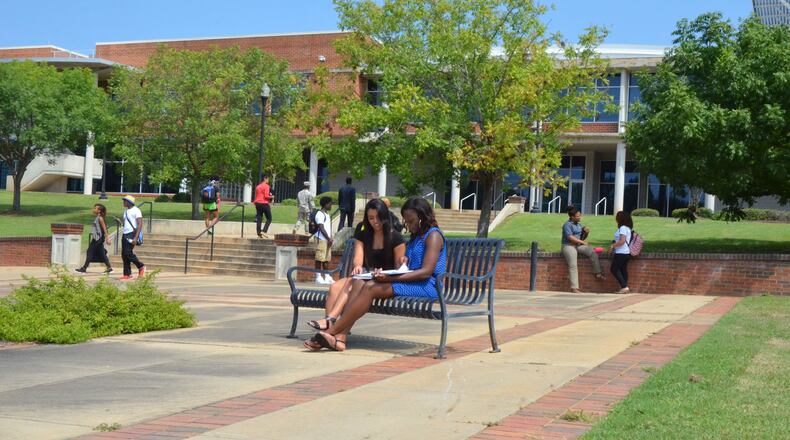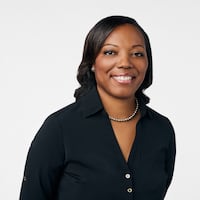What is an HBCU?
The Higher Education Act of 1965, as amended, defines an HBCU as: “…any historically black college or university that was established prior to 1964, whose principal mission was, and is, the education of black Americans, and that is accredited by a nationally recognized accrediting agency or association determined by the Secretary [of Education] to be a reliable authority as to the quality of training offered or is, according to such an agency or association, making reasonable progress toward accreditation.”
Source: White House Initiative on HBCUs
Georgia’s HBCUs
1. Albany State University
2. Clark Atlanta University
3. Fort Valley State University
4. Interdenominational Theological Center
5. Morehouse College
6. Morehouse School of Medicine
7. Morris Brown College*
8. Paine College
9. Savannah State University
10. Spelman College
* - not currently accredited
Source: White House Initiative on Historically Black Colleges and Universities
A feeling overwhelmed Sharesse Shamburger when she stepped onto Clark Atlanta University’s campus four years ago.
For the first time in her life she was surrounded by a sea of black students all striving for the same thing: a college education. Of particular interest were the large numbers of black males in class with her.
“I was so excited to see so many black people in school, especially black men going to college trying to do something with their lives, not being statistics. It was motivational inspiration that just drives you to be better,” Shamburger, 22, said. “It was a breath of fresh air.”
Historically black colleges and universities — there are 10 HBCUs in Georgia and 107 in the nation — were largely created for former slaves and later for blacks who were prevented from enrolling at white schools. The black colleges were key through the mid 20th century in educating and developing much of the black middle class, and continue to cultivate some of the country’s most notable black leaders. The supportive atmosphere found at HBCUs has allowed black students to excel without the racial pressures that exist outside the classroom. Also, many HBCUs, with their family-like environment and long-held traditions still pride themselves on their mission of taking a chance on students other schools won’t.
Some of the schools, such as Atlanta's Spelman College are thriving at a high level, but Georgetown University professor Richard America estimates that at least half of the country's 107 HBCUs identified by the White House Initiative on Historically Black Colleges and Universities are struggling.
“We really can’t talk about them as if they are all in the same boat,” said America, a professor in Georgetown’s McDonough School of Business.
Public HBCUs in states including North Carolina and Louisiana have staved off lawmakers' recommendations to close those that faced enrollment declines and budget shortfalls. The nation's oldest historically black institution of higher learning, Cheyney University of Pennsylvania is facing similar challenges as alumni rally to save the school. Recent turmoil between the president and board stymied leadership at Florida A&M University. Last week Paine College, a small private HBCU in Augusta, announced that it was unable to make payroll for its employees. Morris Brown in Atlanta is teetering on the edge, after financial mismanagement bankrupted the college which has emerged and struggles on with about 40 students.
Many of those are working through leadership controversies and competition from other public and private colleges aggressively recruiting black students. Budget cuts and changes to financial aid are affecting many.
They are dealing with enrollment declines — one of Georgia's public HBCUs, Albany State, has seen a 25 percent enrollment decline over the past five years, which has led state officials to recommend merging the school with another state college. Albany State had recently announced plans for deactivating 10 academic programs. Even Morehouse College, a private flagship college in Atlanta, saw enrollment slip 30 percent since 2005.
And, at a time when colleges are being scrutinized by cost-conscious parents and lawmakers for how efficiently they can graduate students, many HBCUs are grappling with ways to improve their student success rates. The rates typically lower than other colleges in part because of their historic mission — to take students, some unable to enroll in other schools — and give them them their chance at a successful future.
To succeed, those schools will have to think more like businesses: implement strong leadership, reevaluate their missions and strive for higher standards included in popular college rankings, America said.
HBCUs serve more than 300,000 undergraduate and graduate students. About 20.2 million students are expected to attend American colleges this fall, and HBCUs have typically accounted for between 10 percent and 20 percent of black undergraduate students.
The very label of “HBCU” may be part of the problem, he said. “We’re in a new world, and many are still wedded to ideas from the early 20th-century about who they are serving,” he said. “They can still serve the African-American community, but will have to think of themselves as competitive liberal arts colleges, and not in any kind of protective environment.”
Some of the problems for struggling HBCUs are historical stemming from years of unequal treatment. Many of the public HBCUs were founded after the Civil War by legislation requiring states with segregated education systems to provide an institution to educate blacks. The public and private black colleges have produced scores of black professionals despite decades of smaller budgets and poorer facilities afforded white schools.
The underfunding impedes functions that attract and retain students and faculty at some HBCUs, said Robert Palmer, an HBCU researcher and associate professor in Howard University’s department of educational leadership and policy studies.
Despite the challenges, many are still enrolling students who many times come from low-income families, from less than stellar high schools and may be first-generation college students. Serving this demographic of student comes with its own set of challenges and is reflected in national data.
About 75 percent of undergraduate HBCU students receive federal Pell Grants for low-income students, compared to 38 percent of undergraduate students overall.
Nationally, 59 percent of all first-time college students enrolled full time at a four-year institution graduate in six years, according to the National Center for Education Statistics. The six-year graduation rate for black students is 39.5 percent, but the rate drops further at HBCUs, where the six-year graduation rate is 35 percent, according to the United Negro College Fund.
“There are some negatives, but when you have institutions that take in students where they are, that really speaks a lot to the value of HBCUs,” Palmer said.
The problems at black colleges have been well publicized.
The public struggles have led some black students to turn away from them as options.
Attending a black college never crossed Nykki Ogbomoh’s mind.
The Georgia State University junior chemistry major from Cherokee County had never even heard about any black schools other than Morehouse and Spelman colleges.
“My father felt that a black college wouldn’t be much of a challenge for me educationally,” Ogbomoh, 21, said.
At the same time HBCUs are dealing with their own challenges, other institutions have seized the opportunity to become destination institutions for black students. Places such Georgia State, where the the school’s demographics have evolved so much that a white majority no longer exists, have given HBCUs “a run for their money,” said Marybeth Gasman, an education professor at the University of Pennsylvania and director of the Penn Center for Minority Serving Institutions.
Georgia State, which is poised to become the largest college in Georgia next year through a merger, has developed a system of data tracking and academic counseling that has pushed its graduation levels for minority students to virtually the same level of as white students, who typically come to college better prepared and with more family support.
To overcome the challenges struggling HBCUs are recruiting and enrolling more non-black students and establishing partnerships with other institutions, including community colleges, experts said.
And with more states tying education funding to colleges’ performance, Gasman said, they will have to find more ways to improve their student outcomes, like graduation and retention rates that lag non-black schools.
They also need to do a better job of telling their stories, said Brian Bridges, vice president of research and member engagement for the United Negro College Fund.
A Gallup study released last month found that black alumni of historically black colleges and universities are more likely to thrive in their post-graduation lives compared to black graduates of other institutions. The satisfaction is tied to the rich, nurturing experiences found at HBCUs, the study found. Stories of inspiration like Shamburger's are easy to find among HBCU alumni, who favorably recount stories of caring professors, lifelong friendships and a greater sense of belonging and freedom in classrooms of students sharing many of the same life experiences.
“We have a cultural ethos (at HBCUs) that people will care about you,” Bridges said. “If you take advantage of all that a college has to offer you, research has shown you will be more satisfied.”
Stories from students like Laurentiis Gaines, Jr.’s, Albany State’s student government president will have to be shared.
Despite the university’s enrollment and academic struggles Gaines, 21, said he never considered transferring from the school that “felt like home” from the moment he stepped on campus.
“HBCUs were created and directed for us, so the learning experience, the study abroad opportunities, everything that happens at an HBCU is created just for us,” he said. “We never feel just like a number or an unknown individual.”
About the Author
Keep Reading
The Latest
Featured


